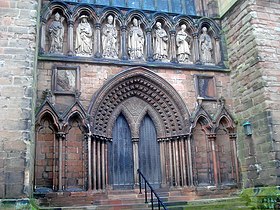
Roman cement is a substance developed by James Parker in the 1780s, being patented in 1796.[1][2]
The name is misleading, as it is nothing like any material used by the Romans, but was a "natural cement" made by burning septaria – nodules that are found in certain clay deposits, and that contain both clay minerals and calcium carbonate. The burnt nodules were ground to a fine powder. This product, made into a mortar with sand, set in 5–15 minutes.[1][2][3] The success of Roman cement led other manufacturers to develop rival products by burning artificial mixtures of clay and chalk.[1][4][5]
- ^ a b c "James Parker's Patent for "Roman Cement" in 1796 (Patent No 2120: granted 28 June, enrolled 27 July)". Cement Kilns. 28 June 1796. Retrieved 20 May 2013.
- ^ a b Roman Kozłowski; David Hughes; Johannes Weber (2010). "Roman cements - key materials of the built heritage of the nineteenth century". In M. Boştenaru Dan; R. Přikryl; Á. Török (eds.). Materials, Technologies and Practice in Historic Heritage Structures. Springer.
- ^ "Roman Cement - What is it?". IATCS - Institute of Art and Technology / Conservation Sciences, University of Applied Arts Vienna. Retrieved 2013-05-20.
- ^ "What is Roman Cement?". Roman Cement, LLC. Retrieved 2013-05-20.
- ^ R. J. M. Sutherland; Dawm Humm; Mike Chrimes (2001). Historic Concrete: The Background to Appraisal. Thomas Telford. pp. 46–52. ISBN 978-0-7277-2875-3. Retrieved 20 May 2013.